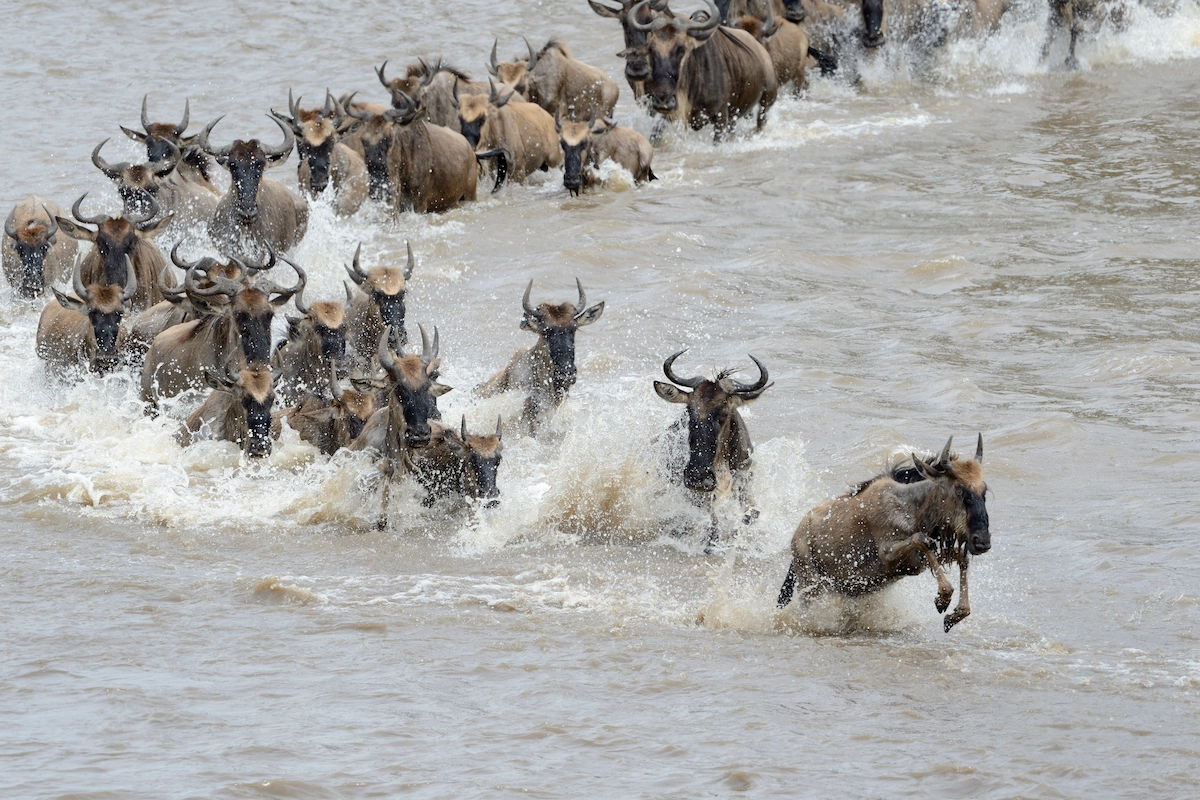
Embark on a 9-day Tanzania Wildebeest Safari. Witness breathtaking river crossings, big cats, and unforgettable wildlife encounters.
What to See:
This 9-Day Tanzania Wildebeest Safari offers a comprehensive experience of Tanzania’s most iconic parks and an up-close view of the Great Wildebeest Migration. In Tarangire National Park, known for its massive elephant herds, you’ll see herds roaming beneath iconic baobab trees, alongside zebras, giraffes, and buffalo. Central Serengeti is the heart of the Serengeti ecosystem, where you can expect to witness vast herds of wildebeest and zebras during the migration, as well as predators such as lions, cheetahs, and leopards in action.
The Northern Serengeti is a prime location for witnessing the dramatic river crossings of the wildebeest migration, with crocodiles lurking in the waters and the herd’s mass movement creating an unforgettable spectacle. Ngorongoro Crater is a UNESCO World Heritage site, teeming with wildlife in its diverse habitats. You may spot the "Big Five"—lions, elephants, rhinos, leopards, and buffalo—within the crater, making it a dream destination for wildlife lovers.
Finally, Lake Manyara National Park, known for its stunning scenery and rich birdlife, provides a unique opportunity to see flamingos, pelicans, and other bird species, as well as tree-climbing lions, which are a rare and fascinating sight.
How to Dress on Safari: The right clothing can make a big difference when it comes to comfort and practicality during your safari. Here’s how to dress:
- Neutral, earth-toned clothing (khaki, beige, green, brown) to blend in with the surroundings and avoid attracting insects. Bright colors and dark colors should be avoided, as they can draw unwanted attention or attract insects.
- Long sleeves and long pants to protect against sun exposure, bugs, and thorny plants, particularly during game drives in national parks like Tarangire and Serengeti.
- Lightweight, breathable clothing for the warmer days, while carrying a light jacket for cooler mornings and evenings, especially in the Serengeti.
- Sturdy hiking boots or closed-toe shoes for walking and traversing rough terrain. Flip-flops are not recommended for safaris.
- A wide-brimmed hat and sunglasses for protection from the sun.
- A light rain jacket or poncho if visiting during the wet season, especially when exploring places like Ngorongoro Crater where it can rain unexpectedly.
What to Carry on Safari: Packing the right essentials will ensure a comfortable and enjoyable safari. Here’s a list of items you’ll want to carry:
- Binoculars to get a closer look at wildlife from a distance, particularly when spotting animals across the vast landscapes of the Serengeti.
- Camera with extra batteries and memory cards to capture those breathtaking moments, from dramatic river crossings in Northern Serengeti to wildlife encounters in Ngorongoro Crater.
- A small daypack for carrying personal items during game drives, such as water, snacks, and your camera.
- Insect repellent to protect against mosquitoes and other bugs.
- Sunscreen to protect against the strong African sun, especially during long hours of game drives.
- A refillable water bottle to stay hydrated, as safari activities can be physically demanding.
- Personal medications and a basic first-aid kit for emergencies, particularly if you have any specific health needs.
- A power bank to keep your phone, camera, or other electronic devices charged during the trip.
Best Time to Travel & Safari Seasons: Tanzania’s safari seasons are divided into two main periods: the dry season and the wet season. The best time to visit largely depends on the type of experience you seek:
- Dry Season (June - October): This is considered the peak safari season, offering the best wildlife viewing opportunities. The Great Wildebeest Migration is at its most dramatic in July - October when the wildebeest cross the Mara River in Northern Serengeti, creating an extraordinary spectacle. During this time, animals gather around water sources, making them easier to spot. The weather is generally dry, and the roads are more accessible for game drives, especially in Ngorongoro Crater and Tarangire.
- Wet Season (November - May): While the wet season may bring some rain, it also offers unique opportunities for birdwatching, as migratory birds flock to Tanzania. The landscapes are lush and green, particularly in Lake Manyara and Ngorongoro Crater, providing a different, picturesque safari experience. The Great Wildebeest Migration is also ongoing during this period, but the herds are mostly concentrated in the southern and central Serengeti regions. The wet season offers fewer crowds and lower prices, making it a good option for a more secluded experience.
For the 9-Day Tanzania Wildebeest Safari – Ultimate Adventure, June to October is the most recommended period, especially for witnessing the Great Migration and enjoying optimal wildlife viewing conditions. However, visiting in the wet season can offer a unique experience with more verdant landscapes and fewer tourists.
This safari encompasses a complete Tanzanian experience, combining the thrill of the wildebeest migration with the stunning wildlife, diverse habitats, and breathtaking landscapes of Tarangire, Serengeti, Ngorongoro Crater, and Lake Manyara. Whether you’re seeking dramatic migration scenes or relaxed game viewing, this journey promises to be an unforgettable adventure.